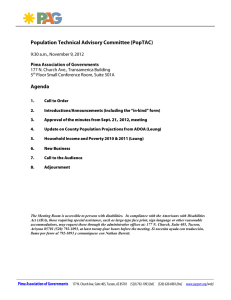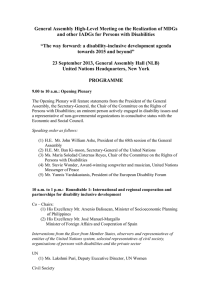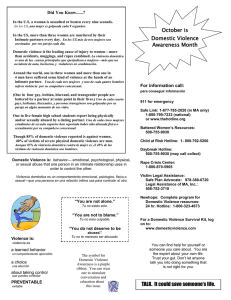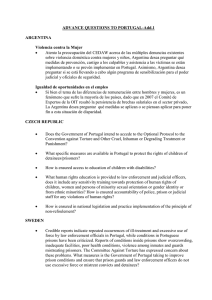Gender-based violence against women with visual
Anuncio
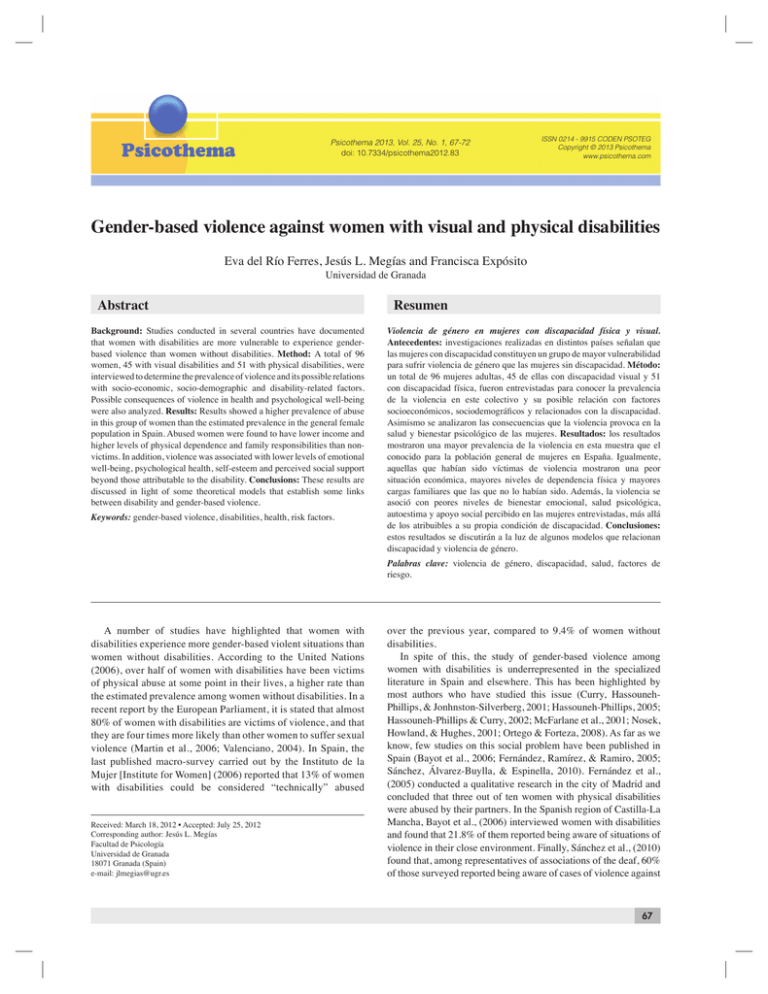
Psicothema 2013, Vol. 25, No. 1, 67-72 doi: 10.7334/psicothema2012.83 ISSN 0214 - 9915 CODEN PSOTEG Copyright © 2013 Psicothema www.psicothema.com Gender-based violence against women with visual and physical disabilities Eva del Río Ferres, Jesús L. Megías and Francisca Expósito Universidad de Granada Abstract Background: Studies conducted in several countries have documented that women with disabilities are more vulnerable to experience genderbased violence than women without disabilities. Method: A total of 96 women, 45 with visual disabilities and 51 with physical disabilities, were interviewed to determine the prevalence of violence and its possible relations with socio-economic, socio-demographic and disability-related factors. Possible consequences of violence in health and psychological well-being were also analyzed. Results: Results showed a higher prevalence of abuse in this group of women than the estimated prevalence in the general female population in Spain. Abused women were found to have lower income and higher levels of physical dependence and family responsibilities than nonvictims. In addition, violence was associated with lower levels of emotional well-being, psychological health, self-esteem and perceived social support beyond those attributable to the disability. Conclusions: These results are discussed in light of some theoretical models that establish some links between disability and gender-based violence. Keywords: gender-based violence, disabilities, health, risk factors. Resumen Violencia de género en mujeres con discapacidad física y visual. Antecedentes: investigaciones realizadas en distintos países señalan que las mujeres con discapacidad constituyen un grupo de mayor vulnerabilidad para sufrir violencia de género que las mujeres sin discapacidad. Método: un total de 96 mujeres adultas, 45 de ellas con discapacidad visual y 51 con discapacidad física, fueron entrevistadas para conocer la prevalencia de la violencia en este colectivo y su posible relación con factores socioeconómicos, sociodemográficos y relacionados con la discapacidad. Asimismo se analizaron las consecuencias que la violencia provoca en la salud y bienestar psicológico de las mujeres. Resultados: los resultados mostraron una mayor prevalencia de la violencia en esta muestra que el conocido para la población general de mujeres en España. Igualmente, aquellas que habían sido víctimas de violencia mostraron una peor situación económica, mayores niveles de dependencia física y mayores cargas familiares que las que no lo habían sido. Además, la violencia se asoció con peores niveles de bienestar emocional, salud psicológica, autoestima y apoyo social percibido en las mujeres entrevistadas, más allá de los atribuibles a su propia condición de discapacidad. Conclusiones: estos resultados se discutirán a la luz de algunos modelos que relacionan discapacidad y violencia de género. Palabras clave: violencia de género, discapacidad, salud, factores de riesgo. A number of studies have highlighted that women with disabilities experience more gender-based violent situations than women without disabilities. According to the United Nations (2006), over half of women with disabilities have been victims of physical abuse at some point in their lives, a higher rate than the estimated prevalence among women without disabilities. In a recent report by the European Parliament, it is stated that almost 80% of women with disabilities are victims of violence, and that they are four times more likely than other women to suffer sexual violence (Martin et al., 2006; Valenciano, 2004). In Spain, the last published macro-survey carried out by the Instituto de la Mujer [Institute for Women] (2006) reported that 13% of women with disabilities could be considered “technically” abused Received: March 18, 2012 • Accepted: July 25, 2012 Corresponding author: Jesús L. Megías Facultad de Psicología Universidad de Granada 18071 Granada (Spain) e-mail: jlmegias@ugr.es over the previous year, compared to 9.4% of women without disabilities. In spite of this, the study of gender-based violence among women with disabilities is underrepresented in the specialized literature in Spain and elsewhere. This has been highlighted by most authors who have studied this issue (Curry, HassounehPhillips, & Jonhnston-Silverberg, 2001; Hassouneh-Phillips, 2005; Hassouneh-Phillips & Curry, 2002; McFarlane et al., 2001; Nosek, Howland, & Hughes, 2001; Ortego & Forteza, 2008). As far as we know, few studies on this social problem have been published in Spain (Bayot et al., 2006; Fernández, Ramírez, & Ramiro, 2005; Sánchez, Álvarez-Buylla, & Espinella, 2010). Fernández et al., (2005) conducted a qualitative research in the city of Madrid and concluded that three out of ten women with physical disabilities were abused by their partners. In the Spanish region of Castilla-La Mancha, Bayot et al., (2006) interviewed women with disabilities and found that 21.8% of them reported being aware of situations of violence in their close environment. Finally, Sánchez et al., (2010) found that, among representatives of associations of the deaf, 60% of those surveyed reported being aware of cases of violence against 67 Eva del Río Ferres, Jesús L. Megías and Francisca Expósito deaf women. Unfortunately there are not enough data available to establish more accurate analyses of the specific features and consequences of this type of violence. It is important to note that women with disabilities may experience not only the same types of abuse as other women but also others related to their disability (Brownridge, 2006; Gilson, Cramer, & DePoy, 2001; Nosek, Clubb, Hughes, & Howland, 2001). These other types of abuse are not usually identified by the instruments most commonly used to assess the phenomenon. Therefore, reported estimates may often underestimate its actual incidence (Nosek, Hughes, Taylor, & Taylor, 2006). There is also a lack of accurate causal models explaining the specific features of abuse experienced by women with disabilities. However, it is worth highlighting two interesting proposals: the Ecological Model developed by Curry et al., (2001) and the Abuse Pathways Model developed by Hassouneh-Phillips (2005). Both models highlight the need for analyses to consider not only known causal factors associated with violence against women but also risk factors associated to the disability that increase the vulnerability of women with disabilities to experiencing abuse. Such factors include greater difficulties finding employment, more financial and physical dependence, less mobility and frequent dependence on caregivers. The impacts of violence on women with disabilities have not been sufficiently explored either. According to Curry et al., (2001), abused women with disabilities experience low selfesteem, feelings of blame, health problems, depression and anxiety, just like non-disabled abused women. However, such symptoms are already present in many of them because they often face discrimination due to their disability. For this reason, these symptoms are not usually associated with violence by the professionals who attend these women (Curry et al., 2001; Gilson et al., 2001). Therefore, further research is needed to distinguish the specific impacts of violence from those of the disability itself on women with disabilities. Objectives Based on these facts, it was considered of great interest to study gender-based violence against women with disabilities. The first aim of this study was to determine the annual and lifetime prevalence of abuse in two groups of women with physical and visual disabilities, respectively. The second objective was to explore the possible role of some of the factors proposed by the theoretical models mentioned above as risk or vulnerability factors for violence: level of education, family and job status, dependence on a caregiver and financial status. The third aim was to analyze the specific impacts of violence on the well-being and health of women with disabilities. Method Participants A total of 96 women with disabilities, of whom 51 had physical disabilities and 45 had visual disabilities, participated in this study. They all have their residence in the city of Granada or its surrounding area and were aged between 19 and 78 years (M= 43.79; SD= 13.12). All of them voluntarily agreed to participate. It was a convenience sample contacted through organizations 68 that help women with disabilities in cooperation with the Centro Municipal de Atención a la Mujer [Municipal Support Center for Women] of the city of Granada. Materials All participants underwent a structured interview including the following instruments: Questionnaire on socio-demographic variables and disability. It included 17 items on socio-demographic characteristics, 15 items on socioeconomic characteristics and 9 items on issues related to the disability, such as level of dependence and need of technical aids. The items were obtained from previous studies on persons with disabilities and/or gender-based violence (Bosch & Ferrer, 2003; Brownridge, 2006; García-Linares et al., 2005; Martin et al., 2006; McFarlane et al., 2001), from indicators proposed by the Observatorio Estatal de Violencia contra la Mujer (2007) [Spanish National Observatory on Violence Against Women], local and national organizations of persons with disabilities (FEGRADI and ONCE) and the Ley 39/2006 de Promoción de la Autonomía Personal y Atención a las Personas en Situación de Dependencia [Spanish Act promoting personal autonomy and care for dependent people]. Scale of health problems or symptoms. It included 22 items assessing health problems or symptoms over the last 6 months (rated from 1 –not at all– to 5 –a lot–); they provided information about issues related to physical and psychological health and severe consequences. The items were obtained from a scale of consequences of violence developed by Walker (2000) and the macro-surveys conducted by the Instituto de la Mujer (1999, 2002, 2006). They were subjected to a principal component analysis with Varimax rotation to determine their factor structure. The results of Bartlett’s test of sphericity, χ² (231)= 736.17, p<.001, and a KMO index= .82 confirmed that the matrix of correlations was suitable to carry out this analysis. The principal component analysis yielded the 3 expected components with eigenvalues greater than 1. The first factor, Psychological problems subscale, obtained an eigenvalue of 6.180 and clustered the 9 items referring to psychological problems such as depression, anxiety and sadness. Cronbach’s α coefficient showed an internal consistency of .89. The second factor, Serious health problems subscale, obtained an eigenvalue of 1.921 and clustered 3 items: hospitalizations, serious injuries and serious disease (α= .61). The third factor, Physical health problems subscale, obtained an eigenvalue of 1.621 and clustered 6 items related to less serious health problems such as headaches, allergies, asthma or backache (α= .57). Drug use scale. It was composed of 5 items assessing consumption over the last 6 months of the drugs most commonly taken to reduce psychological distress (from 1 –never– to 5 –daily–). These included analgesics, tranquilizers, hypnotic drugs and antidepressants, among others. Items were also subjected to a principal component analysis with Varimax rotation. The results of Bartlett’s test of sphericity, χ² (10)= 91.71, p<.001 and a KMO index= .74 indicated that the matrix of correlations was suitable to carry out this analysis. As expected, the analysis showed a single component with eigenvalues= 2.313. Cronbach’s α coefficient showed an internal consistency for this scale of .69. Social Support Inventory (Matud, Padilla, & Gutiérrez, 2005). It includes 12 items referring to individuals’ perceived availability of Gender-based violence against women with visual and physical disabilities support in several domains (e.g. emotional, financial, informational, employment-related), rated from 0 –never– to 3 –always– and clustered into one single factor. The internal consistency of this inventory was α= .88. Satisfaction with Life Scale (Diener, Emmons, Larsen, & Griffin, 1985). This scale has been validated in Spain and is used as a global indicator of quality of life (Atienza, Pons, Balaguer, & García, 2000). It includes 5 items responded in a Likert-type scale ranging from 1 –totally disagree– to 5 –totally agree–. In this study, its internal consistency was α= .87. Self-esteem Scale (Rosenberg, 1989; Spanish version by Martín-Albo, Núñez, Navarro, & Grijalvo, 2007). This is one of the instruments most widely used to assess global self-esteem. It includes 10 items responded on a Likert scale ranging from 1 –strongly agree– to 4 –strongly disagree–. It showed an alpha coefficient of .83. Prevalence of violence. Three instruments were used for this purpose: (1) The Woman Abuse Screening Tool (WAST; Fogarty & Brown, 2002), a short screening test to identify “possible cases” of intimate partner violence. This instrument has been validated in Spain by the Observatorio de Salud de la Mujer (s.f.) [Women’s Health Observatory]. It only includes two items: (a) In general, how would you describe your relationship with you current partner/ex-partner/family?: “A lot of tension”, “Some tension” and “No tension”; and (b) Do you and your current partner/ ex-partner/family work out arguments with: “Great difficulty”, “Some difficulty”, or “No difficulty”? Only women who answered A lot of tension in the first item or Great difficulty in the second item were asked to complete the remaining two questionnaires. (2) The questionnaire to detect violence against women used in the macro-surveys conducted by the Instituto de la Mujer (1999, 2002, 2006). Women were asked to respond to the items of this scale thinking in their whole lifetime instead of just in the last year. This instrument distinguishes between “technical abuse” and “subjective abuse” (Instituto de la Mujer, 2006); technical abuse is defined by responding “sometimes” or “frequently” to any of the 13 items referring to behaviors considered to be violent; subjective abuse is defined by answering “yes” to the question “have you ever experienced a situation in which you felt abused by a family member, your intimate partner or somebody living with you?” Participants were asked to respond to this question considering both the last year and their whole lifetime. (3) Participants completed two items of the Abuse Assessment Screen-Disability (AAS-D; McFarlane et al., 2001) specifically aimed at identifying disability-related abuse: (a) Within the last year, has anybody you depend on refused to help you with an important personal need (related to your basic daily activities), such as taking your medicine, getting to the bathroom, getting out of bed, bathing, getting dressed, or getting food and drink? and (b) Within the last year, has anyone prevented you from using any of the technical aids you need in your daily life, such as a wheelchair, cane, respirator, or other assistive devices? Items were responded on a 4-point Likert scale ranging from “not at all” to “yes, continuously”. Data analysis The first step was to identify percentages of annual and lifetime prevalence of abuse in the sample; the second step was to analyze the socio-demographic differences between victims of abuse and non-victims using Chi-square and Student’ t tests. Finally, to determine the impacts of violence, a 2×2 MANCOVA was performed with two fixed factors; one factor was defined by the two groups of women (Abused vs. Non-abused) and the other factor was defined by the type of disability (Physical vs. Visual), considering participant age as a covariate. Results Prevalence of violence The WAST screening questionnaire identified 43 possible cases of abuse (44.8%) (see Table 1), with a similar distribution in both disability groups (n= 23 in visual disability and n= 20 in physical disability). The questionnaire of the macro-survey conducted by the Instituto de la Mujer (2006) confirmed that, at some point in their lives, 39 of these women (40.6% of the total sample) could be considered “technically abused” by their intimate partner, expartner, a relative or somebody close to them that they currently lived with or had lived with; the distribution was also very similar in both groups (n= 19 in visual disability and n= 20 in physical disability). Of these 39 women, 29 (30.2% of the total sample) recognized themselves as having been abused at some point in their lives, that is, they satisfied the criterion of “subjective abuse” (n= 12 in the visual disability group and n= 17 in the physical disability group). Among these 29 women, 12 (12.5% of the total sample) admitted experiencing abuse within the last year (see Table 1). The specific questions on disability and abuse belonging to the AAS-D identified that 10.4% (n= 10) of participants had been abused. Only three of these women had been previously considered “technically abused” by the indicators of the macrosurvey. Therefore, the AAS-D revealed that an additional 7.3% (n= 7) of women had been victims of abuse. In sum, for all of the study women, the prevalence of some type of abuse occurring during their lifetime was 47.9% (n= 46). This percentage was similar in both disability groups (49% in the Table 1 Abuse prevalence according to the different indicators used Women with visual disabilities n= 45 Women with physical disabilities n= 51 WAST 23 (51%) 20 (39.2%) χ²(1, N = 96)= 1.37, p= .24 Technical abuse (lifetime) 19 (42.2%) 20 (39.2%) χ² <1 Procedure Subjective abuse (lifetime) 12 (26.7%) 17 (33.3%) χ² <1 After giving their informed consent, participants were interviewed in one session by research collaborators specially trained for that purpose. The interviews lasted between 60 and 90 minutes. Subjective abuse (last year) 6 (13.3%) 6 (11.8%) χ²<1 AAS-D 3 (6.7%) 7 (13.7%) χ²(1, N = 96)= 1.28, p= .26 69 Eva del Río Ferres, Jesús L. Megías and Francisca Expósito physical disability group, n= 25, and 46.7% in the visual disability group, n= 21). Risk and vulnerability factors for abuse To analyze the possible role of some socio-demographic and disability-related variables as risk and vulnerability factors for abuse, the total sample was divided into two groups: (a) women who satisfied the criterion of “technical abuse” at some point in their lives or had been identified as such by the AAS-D (McFarlane et al., 2001) (n= 46); and (b) the remaining women, who formed the group of non-abused women (n= 50). Both types of disabilities were equally represented in both groups, χ² (1, n= 96)= .05, n.s. As shown in Table 2, differences in some socio-demographic and socioeconomic factors were found between groups. Women in the non-abused group reported a higher level of formal education than women belonging to the abused group. On the other hand, 37% of women who had experienced situations of abuse claimed not to have children and the most frequent number of children Table 2 Socio-demographic, socioeconomic, and disability-related characteristics of women by violence status Education No Formal Education Primary Education Professional Education Secondary Education University Degree Number of children Number of children distribution None One Two Three More than three Employment Employed Unemployed Women’s economic dependence Families’ economic dependence on women Women’s dependence due to their disability status Distribution of disability status None (0) Level 1 Moderate (1) Level 2 Severe (2) Level 3 Maximun (3) Abused (n= 46) % Non abused (n= 50) % 10.9 30.4 17.4 10.9 30.4 6 22 4 28 40 Mean (SD) 1.57 (1.9) Mean (SD) 1.1 (1.4) t(94)= 1.4 37 21.7 10.9 23.9 6.5 52 8 30 4 6 χ²(4, N= 96)= 15.55** 39.1 60.9 48 52 42 χ² <1 33.3 14.3 χ² (1, N= 96)= 4.75* Mean (SD) .61 (.91) Mean (SD) .18 (.44) t(94)= 3** 60.9 23.9 8.7 6.5 84 14 2 0 Mean (SD) Mean (SD) 1500 (1027.1) 2130 (1352.5) Age 45.35 (13.10) 70 42.36 (13.09) Consequences of violence on the well-being and health of women with disabilities To determine the impacts of abuse on the well-being and health of women, we conducted a 2×2 MANCOVA with two fixed factors: the first one defined by the experiences with violence (Abused vs. Non-abused women) and the second by the type of disability (Physical vs. Visual), considering participant age as a covariate. The following dependent variables were tested: psychological problems, physical health problems, serious health problems, drug use, perceived social support, psychological well-being and selfesteem. Results of this analysis showed main effects of the fixed factors Abused/Non abused, Wilks’ λ= .77, F(7, 85)= 3.66, p<.01, η²= .23, and type of disability, Wilks’ λ= .83, F(7, 85)= 2.55, p<.05, η²= .17, and of the covariate (age), Wilks’ λ= .70, F(7, 85)= 5.17, p<.001, η²= .30. None of the interactions between these variables reached statistical significance. As can be seen in Table 3, abused women showed a higher frequency of psychological problems, and lower perceived social support, psychological well-being, and self-esteem, than nonabused women. However, no relationship was found between experiencing abuse or not and physical health problems, serious health problems, or drug use. Women with physical disabilities reported more health problems than women with visual disabilities (see Table 4), including psychological problems, physical problems, and serious problems; they also reported more frequent drug use, lower psychological well-being, and lower self-esteem. No differences were found between both groups in perceived social support. χ²<1 37 Family Income * p<.05; ** p<.01 χ²(4, N= 96)= 9.63* per woman was 3 (23.9% of women); in the non-abused women group, however, the percentage of women who claimed not to have children was higher (52%) and the most frequent number of children was 2 (30%). In addition, abused women perceived that their family depended on them for economic sustenance to a greater extent than non-abused women (33.3% vs. 14.3%) and also exhibited a higher level of dependence due to their disabilities (M= .61 vs. M= .18). Finally, the average income per month of abused women was also lower than that of non-abused women (M= 1,500 € vs. M= 2,130 €). χ² (3, N= 96)= 8.34* t(94)= -2.55* t(94)= 1.11 Table 3 Dependent variables by abuse status Abused women n= 46 Non abused women n= 50 M SD M SD F(1,91) η² Psychological problems 2.37 1.04 1.92 .82 4.46* .05 Physical Problems 2.14 .72 1.95 .53 1.08 .01 Severe Health Problems 1.38 .54 1.45 .74 0.54 .01 Medicine Consumption 2.05 1.03 1.68 .73 2.42 .03 Social Support 1.61 .74 2.07 .62 8.97** .09 Psychological Well-Being 2.83 1.00 3.63 .92 15.81** .15 Self-Esteem 2.10 .46 1.87 .42 5.36* .06 p<.05; ** p<.01 Gender-based violence against women with visual and physical disabilities Table 4 Dependent variables by disability status Physical disability n= 51 Visual disability n= 45 M SD Psychological problems 2.40 1.00 Physical Problems 2.16 .63 Severe Health Problems 1.60 .78 1.21 Medicine Consumption 2.00 1.03 Social Support 1.82 .67 Psychological Well-Being 3.04 1.02 Self-Esteem 2.04 .51 † M SD F(1, 91) η² 1.83 .80 12.51** .12 1.91 .63 7.85** .08 .38 9.95** .10 1.68 .70 8.30** .08 1.88 .77 1.29 .01 3.48 1.00 5.17* .05 1.92 .37 3.19† .03 p<.10; * p<.05; ** p<.01 As regards the covariate, compared to younger participants, older participants reported more psychological problems, F(1, 91)= 4.69, p= .03, η²= .05, and physical health problems, F(1, 91)= 11.36, p= .001, η²= .11, higher drug use, F(1, 91)= 19.06, p<.001, η²= .17, lower perceived social support, F(1,91)= 10.04, p= .002, η²= .10, and lower self-esteem, F(1, 91)= 3.99, p= .05, η²= .04. However, no relationship was found between age and serious health problems or perceived psychological well-being (both Fs <1). Discussion First of all, results of this study showed a high lifetime prevalence of “technical abuse” among women with disabilities (47.9%). This is higher than that found in the women general population and in the case of women with disabilities by the most recently published macro-survey of the Instituto de la Mujer (2006). Yet, it is consistent with data from previous studies reviewed and estimates on these groups provided by international and European organizations (Brownridge, 2006; CERMI, 2008; HassounehPhillips, 2005; McFarlane et al., 2001; Martin et al., 2006; Nosek et al., 2001; United Nations, 2006; Valenciano, 2004). Second, consistent with the considerations of McFarlane et al., (2001), the use of specific indicators of abuse for women with disabilities identified an additional 7.3% of situations of abuse that had not been revealed by the “official” macro-survey used in Spain. Third, some socio-demographic and socioeconomic factors were found to be related with abuse of women with disabilities. These included having less formal education, more family responsibilities, less financial resources and greater physical dependence on others. These results are partly consistent with the risk factors proposed in the Ecological Model developed by Curry et al., (2001) and the vulnerability factors proposed in the Abuse Pathways Model by Hassouneh-Phillips (2005). Fourth, the comparison between two types of women with disabilities (Abused vs. Non-abused) identified specific impacts of violence, distinguishing them from those attributable to the disability itself: problems regarding psychological health, psychological well-being, self-esteem and social isolation. These data complete those obtained by previous studies on women with disabilities in Spain and other countries (Bayot et al., 2006; Curry et al., 2001; Fernández et al., 2005; Nosek et al., 2006; Sánchez et al., 2010) and corroborate that the impacts of abuse on these women are similar to those of abuse on women without disabilities (Campbell, 2002; Matud, 2004; Matud et al., 2005; Ruiz-Pérez & Plazaola-Castaño, 2005). However, the present study has certain limitations that should be mentioned. The difficulty accessing other groups of women with disabilities (e.g., deaf women, women with psychological disabilities or institutionalized women) compromises the generalization of results. Moreover, convenience sampling has disadvantages compared to other methods. Finally, two of the scales used had low internal consistency values. Despite these shortcomings, we consider that these findings have an important value in themselves, as they confirm that in the Spanish cultural context women with disabilities experience gender-based violence with greater intensity than non-disabled women. They also show the need to use specific instruments to identify abuse and highlight the role as risk factors of certain socio-demographic and socioeconomic factors, some of which are strongly related to the disability itself. Acknowledgments This research was possible thanks to the cooperation and funding provided by the Centro Municipal de Atención a la Mujer [Municipal Support Center for Women] of the City of Granada and the funding from the Spanish Ministry of Science and Innovation (Grant no. PSI2010-15139) and the Regional Government of Andalusia (Grant no. SEJ2010-6225). References Atienza, F.L., Pons, D., Balaguer, I., & García, M. (2000). Propiedades psicométricas de la Escala de Satisfacción con la vida en adolescentes. Psicothema, 12, 314-319. Bayot, A., Escudero, I., Sebastiá, S., de Julián, L.F., Escobar, E.M., Jiménez, R., & Carrobles, M. (2006). Estudio cualitativo de la situación de la mujer con discapacidad en Castilla La Mancha. Castilla La Mancha: COCEMFE. Bosch, E., & Ferrer, V.A. (2003). Mujeres maltratadas: análisis de características sociodemográficas, de la relación de pareja y del maltrato. Intervención Psicosocial, 12, 325-344. Brownridge, D.A. (2006). Partner violence against women with disabilities: Prevalence, risk, and explanations. Violence Against Women, 12, 805-822. Campbell, J.C. (2002). Health consequences of intimate partner violence. Lancet, 359, 1331-1336. CERMI (Ed.) (2008). Reconociendo los derechos de las niñas y mujeres con discapacidad. Un valor añadido para la sociedad futura. Madrid: CINCA. Curry, M.A., Hassouneh-Phillips, D., & Jonhnston-Silverberg, A. (2001). Abuse of women with disabilities. An ecological model and review. Violence Against Women, 7, 60-79. Diener, E., Emmons, R.A., Larsen, R.J., & Griffin, S. (1985). The satisfaction with Life Scale. Journal of Personality Assessment, 49, 71-75. Fernández, P., Ramírez, M.J., & Ramiro, P. (2005). Diagnóstico social sobre violencia de género y discapacidad en la ciudad de Madrid. Madrid: Ayuntamiento de Madrid. 71 Eva del Río Ferres, Jesús L. Megías and Francisca Expósito Fogarty, C.T., & Bown, J.B. (2002). Screening for abuse in Spanishspeaking women. Journal of the American Board of Family Medicine, 15, 101-111. García-Linares, M., Pico-Alfonso, M., Sánchez-Lorente, S., SavallRodríguez, F., Celda-Navarro, N., Blasco-Ros, C., & Martínez, M. (2005). Assessing physical, sexual and psychological violence perpetrated by intimate male partners toward women: A spanish crosssectional study. Violence and Victims, 20, 99-123. Gilson, S.F., Cramer, E.P., & DePoy, E. (2001). Redefining abuse of women with disabilities: A paradox of limitation and expansion. Afilia, 16, 220-235. Hassouneh-Phillips, D. (2005). Understanding abuse of women with physical disabilities. An overview of the abuse pathways model. Advance in Nursing Science, 28, 70-80. Hassouneh-Phillips, D., & Curry, M.A. (2002). Abuse of women with disabilities: State of the science. Rehabilitation Counseling Bulletin, 45, 96-1003. Instituto de la Mujer (1999). Macroencuesta sobre la violencia contra las mujeres. Informe de resultados. Madrid: Sigmados. Instituto de la Mujer (2002). II Macroencuesta sobre la violencia contra las mujeres. Informe de resultados. Madrid: Sigmados. Instituto de la Mujer (2006). III Macroencuesta sobre la violencia contra las mujeres. Informe de resultados. Madrid: Sigmados. Ley 39/2006 de Promoción de la Autonomía Personal y Atención a las personas en situación de dependencia. BOE nº 299, 14 de diciembre, 2006. Martin, S.L., Ray, N., Sotres-Álvarez, D., Kupper, L.L., Moracco, K.E., Dickens, P.A., Scandlin, D., & Gizlice, Z. (2006). Physical and sexual assault of women with disabilities. Violence Against Women, 12, 823837. Martín-Albo, J., Núñez, J., Navarro, J., & Grijalvo, F. (2007). The Rosenberg Self-Esteem Scale: Translation and validation in university students. The Spanish Journal of Psychology, 10, 458-467. Matud, M.P. (2004). Impacto de la violencia doméstica en la salud de la mujer maltratada. Psicothema, 16, 397-401. Matud, M.P., Padilla, V., & Gutiérrez, A.B. (2005). Mujeres maltratadas por su pareja. Guía de tratamiento psicológico. Madrid: Minerva Ediciones. 72 McFarlane, J., Hughes, R.B., Nosek, M.A., Groff, J.Y., Swedlend, N., & Dolan Mullen, P. (2001). Abuse assessment screen-disability (AAS-D). Measuring frequency, type, and perpetrator of abuse toward women with physical disabilities. Journal of Women’s Health and GenderBased Medicine, 10, 861-866. Nosek, M.A., Clubb, C., Huges, R.B., & Howland, C.A. (2001). Vulnerabilities for abuse among women with disabilities. Sexuality and Disability, 19, 177-189. Nosek, M.A., Howland, C.A., & Hughes, R.B. (2001). The investigation of abuse and women with disabilities: Going beyond assumptions. Violence Against Women, 7, 477-499. Nosek, M.A., Hughes, R.B., Taylor, H.B., & Taylor, P. (2006). Disability, psychosocial and demographic characteristics of abused women with physical disabilities. Violence Against Women, 12, 838-850. Observatorio de Salud de la Mujer (s.f.). Adaptación española de un instrumento de diagnóstico y otro de cribado para detectar la violencia contra la mujer en la pareja desde el ámbito sanitario. Documento de trabajo. Observatorio Estatal de Violencia sobre la Mujer (2007). Sistema de indicadores y variables sobre violencia de género sobre el que construir la base de datos del Observatorio Estatal de Violencia sobre la Mujer. Madrid: Ministerio de Trabajo y Asuntos Sociales. Ortego, J.L., & Forteza, M.D. (2008). Violencia de género y discapacidad. In E. Bosch, (Ed.), Violencia de género. Algunas cuestiones básicas (pp. 107-146). Jaén, Spain: Formación Alcalá. Rosenberg, M. (1989). Society and the adolescent self-image. Middeltown, CT: Wesleyan University Press. Ruiz-Pérez, I., & Plazaola-Castaño, J. (2005). Intimate partner violence and mental health consequences in women attending family practice in Spain. Psychosomatic Medicine, 67, 791-797. Sánchez, C., Álvarez-Buylla, S., & Espinella, B. (2010). Situación de las mujeres sordas ante la violencia de género. Madrid: Confederación Estatal de Personas Sordas. United Nations (2006). In-depth study on all forms of violence against women. A/61/122/Add.1. Retrieved from http://www.unifem.org/ gender_issues /violence_against_women/. Valenciano, E. (2004). Informe sobre la situación de las mujeres de los grupos minoritarios en la Unión Europea. European Parlament. Walker, L. (2000). Battered woman syndrome. New York: Springer.


